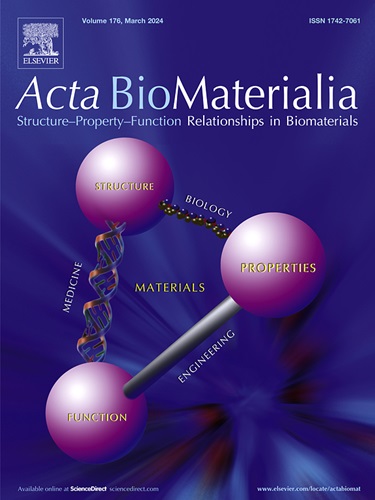Dual cell-penetrating peptide-conjugated polymeric nanocarriers for miRNA-205–5p delivery in gene therapy of cutaneous squamous cell carcinoma
IF 9.4
1区 医学
Q1 ENGINEERING, BIOMEDICAL
引用次数: 0
Abstract
Despite the potential of microRNAs (miRNAs) in suppressing tumorigenesis, the main challenges are achieving tumor-specific selectivity and efficient delivery into cancer cells. In this study, miR-205–5p-loaded polymeric nanoparticles conjugated with dual cell-penetrating peptides (CPPs) were designed for targeting and treating cutaneous squamous cell carcinoma (cSCC). The CPPs, R9, and p28, demonstrated high cell-penetrating/targeting abilities and antitumor activity. The anti-cSCC effect of the nanocarriers was examined using in vitro cellular 2D and 3D models and in vivo spheroid-xenografted murine models. The average size of the dual CPP-conjugated nanocarriers was 193 nm with a zeta potential of 5.7 mV. These nanocarriers were readily internalized by A431 cells, resulting in decreased proliferation compared to naked agomiR and nanoparticles with a single CPP. The nanocarriers induced cell cycle arrest in the G0/G1 stage. By loading the miR-205–5p mimic, the dual CPP-conjugated nanoparticles enhanced cell apoptosis threefold compared to the control, activating caspases and poly(ADP-ribose) polymerase (PARP). The wound healing assay demonstrated that the nanocarriers significantly inhibited the migration and invasion of cSCC cells. Additionally, the CPP-conjugated nanocarriers penetrated cSCC 3D spheroids, reducing spheroidal size and proliferation. In vivo studies demonstrated that the intratumoral CPP-conjugated nanocarriers achieved a 30 % reduction in tumor volume than the PBS control. The number of Ki67-positive cells in the nanocarrier-treated tumor decreased fivefold than the untreated tumors. The nanoparticulate agomiR (1 μM) exhibited no cytotoxicity towards normal keratinocytes. No significant toxicity was observed in the skin and peripheral organs following subcutaneous administration of the nanoparticles in healthy mice. These findings demonstrate that miR-205–5p mimic delivery via dual CPP-conjugated nanocarriers can promote efficient and safe cSCC regression.
Statement of significance
Cutaneous squamous cell carcinoma (cSCC) is a highly invasive skin malignancy with limited treatment options. This study introduces dual cell-penetrating peptide (CPP)-conjugated polymeric nanoparticles for delivering miR-205–5p, a tumor-suppressor microRNA, to cSCC cells. The nanosystem enhances cellular uptake, inhibits cell proliferation, and promotes apoptosis in both 2D and 3D tumor models. In vivo, the nanocarriers demonstrate significant antitumor efficacy with minimal toxicity, highlighting their potential as a targeted, non-invasive therapy. This research represents a promising advance in gene therapy for cSCC by combining nanotechnology and CPPs to address challenges in miRNA delivery and tumor targeting.

双细胞穿透肽偶联聚合物纳米载体在皮肤鳞状细胞癌基因治疗中的传递
尽管microRNAs (miRNAs)在抑制肿瘤发生方面具有潜力,但主要的挑战是实现肿瘤特异性选择性和有效递送到癌细胞中。在这项研究中,负载mir -205-5p的聚合物纳米颗粒结合双细胞穿透肽(CPPs)被设计用于靶向和治疗皮肤鳞状细胞癌(cSCC)。cps R9和p28表现出高的细胞穿透/靶向能力和抗肿瘤活性。采用体外二维、三维细胞模型和体内球体异种移植小鼠模型检测纳米载体的抗cscc作用。双cpp共轭纳米载体的平均尺寸为193 nm, zeta电位为5.7 mV。这些纳米载体很容易被A431细胞内化,导致与裸agomiR和单一CPP纳米颗粒相比,增殖降低。纳米载体诱导细胞周期阻滞在G0/G1期。通过加载miR-205-5p模拟物,与对照组相比,双cpp共轭纳米颗粒激活半胱天蛋白酶和聚(adp -核糖)聚合酶(PARP),使细胞凋亡增强了三倍。伤口愈合实验表明,纳米载体明显抑制cSCC细胞的迁移和侵袭。此外,cpp缀合的纳米载体穿透cSCC三维球体,减小球体尺寸和增殖。体内研究表明,与PBS对照相比,肿瘤内pcp共轭纳米载体的肿瘤体积减少了30%。在纳米载体处理的肿瘤中,ki67阳性细胞的数量比未处理的肿瘤减少了5倍。纳米粒agomiR (1 μM)对正常角质形成细胞无细胞毒性。在健康小鼠皮下给药后,未观察到对皮肤和周围器官的明显毒性。这些研究结果表明,通过双pcp共轭纳米载体递送miR-205-5p模拟物可以促进高效、安全的cSCC回归。意义声明:皮肤鳞状细胞癌(cSCC)是一种高度侵袭性的皮肤恶性肿瘤,治疗方案有限。本研究引入双细胞穿透肽(CPP)共轭聚合物纳米颗粒,用于将miR-205-5p(一种肿瘤抑制microRNA)递送到cSCC细胞。在二维和三维肿瘤模型中,纳米系统增强细胞摄取,抑制细胞增殖,促进细胞凋亡。在体内,纳米载体表现出显著的抗肿瘤功效,毒性很小,突出了它们作为靶向、非侵入性治疗的潜力。本研究通过结合纳米技术和CPPs来解决miRNA传递和肿瘤靶向方面的挑战,代表了cSCC基因治疗的一个有希望的进展。
本文章由计算机程序翻译,如有差异,请以英文原文为准。
求助全文
约1分钟内获得全文
求助全文
来源期刊

Acta Biomaterialia
工程技术-材料科学:生物材料
CiteScore
16.80
自引率
3.10%
发文量
776
审稿时长
30 days
期刊介绍:
Acta Biomaterialia is a monthly peer-reviewed scientific journal published by Elsevier. The journal was established in January 2005. The editor-in-chief is W.R. Wagner (University of Pittsburgh). The journal covers research in biomaterials science, including the interrelationship of biomaterial structure and function from macroscale to nanoscale. Topical coverage includes biomedical and biocompatible materials.
 求助内容:
求助内容: 应助结果提醒方式:
应助结果提醒方式:


